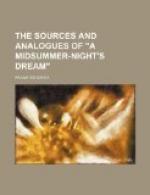The romance of Thomas of Erceldoune is a poem in three “fyttes” or sections, which is preserved wholly or in part in five manuscripts, of which the earliest may be dated about 1435. The poem tells us that Thomas of Erceldoune’s prophetic power was a gift from the queen of Elf-land, with whom he paid a visit to her realm. The first “fytte” is occupied in narrating his sojourn;[57] while the other two set forth the predictions with which the queen supplied him. The romance is probably of Scottish origin, as the prophecies treat mainly of Scottish history; but the first “fytte” (which alone concerns us here, and indeed appears to be separate in origin from the other two) refers to an “older story.” This, Professor Child says, “was undoubtedly a romance which narrated the adventure of Thomas with the elf queen simply, without specification of his prophecies.”
Doubtless the older story was not originally attached to Thomas of Erceldoune, who, as “Thomas Rymour of Ercildoune,” is a historical character. He lived, as is proved by contemporary documents, in the thirteenth century, at Ercildoune (Earlstoun on the banks of the Leader in Berwickshire), and gained a reputation as a “rymour,” i.e. poet and prophet—in which character he was venerated by the folk for centuries.
But the Rymour does not concern us; the tale of a mortal’s visit to elf-land would have been told of some one, whether Thomas or another; he was a prophet, and prophets needed explanation. His journal to fairy-land, as narrated in the fifteenth-century romance, survives in the well-known ballad of Thomas the Rhymer.[58]
Two points in romance and ballad may be noted. (i) In the romance the lady shows Thomas four roads, leading respectively to heaven, paradise, purgatory, and hell, besides the fair castle of Elf-land. The ballad is content with three roads, to heaven, hell, and Elf-land. (ii) Both in the romance and the ballad, and also in Ogier the Dane, the hero makes the same mistake, of supposing his supernatural visitor to be the Virgin Mary.[59]
A curious point about the first “fytte” is that it opens (ll. 1-18) in the first person; at line 41 Thomas is mentioned, and the poem continues in the third person to the end, with a single and sudden change to the first in line 208. I do not know whether any assumption as to the authorship of the romance can be based on such facts; the “I” question in early popular poetry forms an interesting study in itself.[60]
The English romance of Sir Launfal, which survives in a manuscript[61] of the fifteenth century, is therein said to have been “made by Thomas Chestre”; but in fact it is chiefly a translation from Marie de France’s lay of Lanval, dating from the middle of the thirteenth century. The translator, Thomas Chestre, has, however, taken incidents from other “lais” by Marie de France, and enlarged the whole until it is some three hundred lines longer than the French original.




